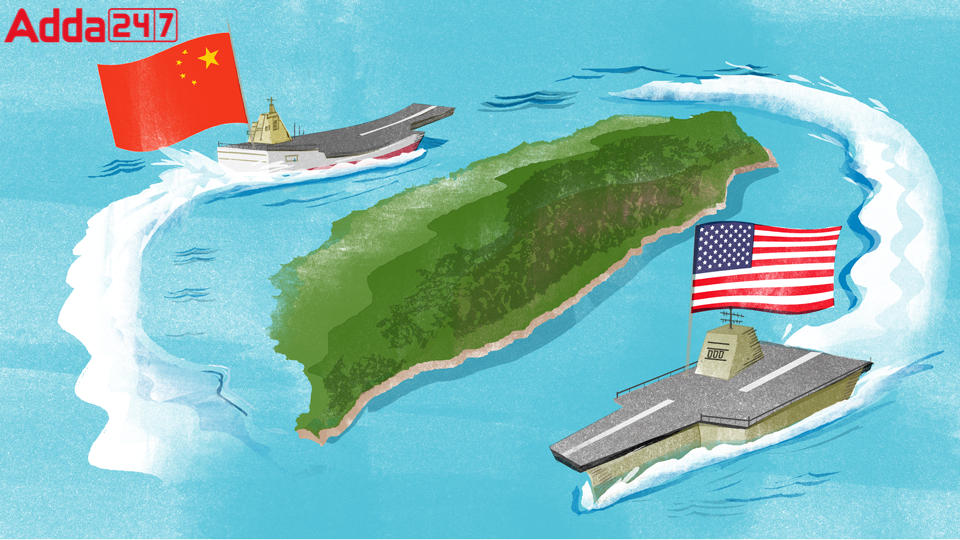Two U.S. Navy warships sailed through international waters in the Taiwan Strait, the first such operation since a visit to Taiwan by U.S. House Speaker Nancy Pelosi enraged China which regards the island as its territory. The U.S. Navy, said cruisers Chancellorsville and Antietam were carrying out the ongoing operation. Such operations usually take eight to 12 hours to complete and are closely monitored by China’s military.
Bank Maha Pack includes Live Batches, Test Series, Video Lectures & eBooks
The Long-drawn Line:
For nearly 70 years an imagined line running down the Taiwan Strait between Taiwan and China has helped keep the peace but the so-called median line is looking increasingly meaningless as China’s modernised navy asserts its strength. China has never officially recognised the line that a U.S. general devised in 1954 at the height of Cold War hostility between Communist China and U.S.-backed Taiwan although the People’s Liberation Army largely respected it. Now Taiwan is bracing for warships from China’s much larger navy routinely pushing over the line as part of the steps an angry Beijing has taken to protest against a visit to Taipei three weeks ago by U.S. House Speaker Nancy Pelosi.
Projection Of Power:
Taiwan would have to react militarily if Chinese forces entered its 12 nautical miles of territorial waters, the Taiwan official said, but apart from that, there was no immediate plan to give the military or coastguard more authority to respond. President Tsai Ing-wen has repeatedly said Taiwan will neither provoke nor escalate conflict. It is questionable whether international support for Taiwan is sufficient to deter China from patrolling into Taiwan’s side of one of the world’s busiest shipping lanes, or if Taiwan’s friends would help it maintain the line. Ships of the U.S. and other Western navies sail through the strait to highlight what they maintain is its international status, not to strictly enforce the imaginary line that has no legal standing.
About Taiwan Strait:
The Taiwan Strait is some 180 km (110 miles) wide and at its narrowest, the median line is about 40 km (25 miles) from Taiwan’s waters. An established Chinese naval presence close to Taiwan’s territorial waters would stretch Taiwan’s military and make any Chinese blockade or invasion much easier, Taiwanese officials warn. Ultimately, a redundant median line would also usher in further challenge to the long-standing U.S. dominance of China’s near seas – the so-called first island chain – and help China to project its power into the Pacific.
U.S-China Political Artefact:
Chieh Chung, a security analyst from the National Policy Foundation think tank in Taipei, said the “overthrowing” of the median line consensus had increased the risk of accidental conflict. Chieh said the codes of engagement for Taiwan’s coastguard and military should be reviewed to give them more authority and legal protection in reacting to increasingly complex challenges from Chinese forces. Within weeks, U.S. warships are expected to sail through the Taiwan Strait, underscoring what they see as its status as an international waterway, to the inevitable annoyance of China, which claims sovereignty and other rights over the strait. But the U.S. ships are not expected to challenge Chinese vessels on either side of the median line.
The Taiwan-China Development:
- Taiwan, officially known as the Republic of China (ROC), is an island separated from China by the Taiwan Strait. It has been governed independently of mainland China, officially the People’s Republic of China (PRC), since 1949. The PRC views the island as a renegade province and vows to eventually “unify” Taiwan with the mainland. In Taiwan, which has its own democratically elected government and is home to twenty-three million people, political leaders have differing views on the island’s status and relations with the mainland. Cross-strait tensions have escalated since the election of Taiwanese President Tsai Ing-wen in 2016. Tsai has refused to accept a formula that her predecessor, Ma Ying-jeou, endorsed to allow for increased cross-strait ties.
- Meanwhile, Beijing has taken increasingly aggressive actions, including by flying fighter jets near the island. Some analysts fear a Chinese attack on Taiwan has the potential to draw the United States into a war with China. In a 2019 speech, Xi reiterated China’s long-standing proposal for Taiwan: that it be incorporated into the mainland under the formula of “one country, two systems.” This is the same formula used for Hong Kong, which was guaranteed the ability to preserve its political and economic systems and granted a “high degree of autonomy.” Such a framework is deeply unpopular among the Taiwanese public. Pointing to Beijing’s recent crackdown on Hong Kong’s freedoms, Tsai and even the KMT have rejected the “one country, two systems” framework.
The Recent U.S Approach:
Under President Donald Trump, the United States deepened ties with Taiwan over Chinese objections, including by selling more than $18 billion worth of arms to the military and unveiling a $250 million complex for its de facto embassy in Taipei. Trump spoke with Tsai by telephone ahead of his inauguration, the highest level of contact between the two sides since 1979. The Biden administration has taken a similar approach, continuing arms sales and affirming the Trump administration’s decision to allow U.S. officials to meet more freely with Taiwanese officials. Biden was the first U.S. president to invite Taiwanese representatives to attend the presidential inauguration. The United States participates in military training and dialogues with Taiwan, regularly sails ships through the Taiwan Strait to demonstrate its military presence in the region, and has encouraged Taiwan to increase its defense spending.



 Indian Olympic Medal Winners List Till N...
Indian Olympic Medal Winners List Till N...
 Who is the Inventor of the Gramophone?
Who is the Inventor of the Gramophone?
 HS Dhaliwal Appointed New DGP Of Andaman...
HS Dhaliwal Appointed New DGP Of Andaman...
